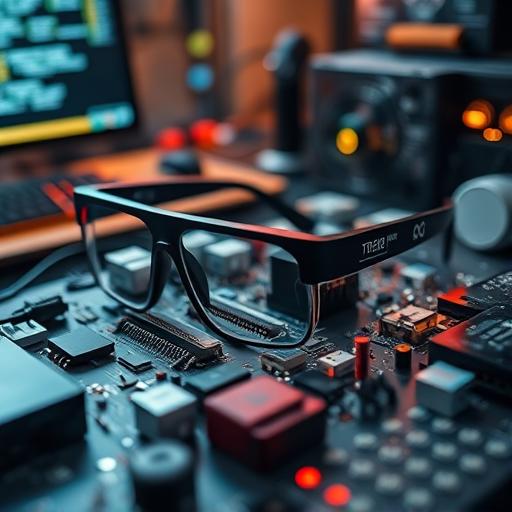Imagine a world where information, communication, and entertainment are seamlessly integrated into your field of vision, accessible with a simple voice command or gesture. Smart glasses, once a futuristic concept, are now bridging the gap between digital innovation and real-world application. These wearable devices combine augmented reality (AR), hands-free computing, and intuitive interfaces to redefine how we interact with technology. As they evolve from niche prototypes to mainstream tools, smart glasses are poised to transform industries and reshape daily life in ways we’re only beginning to grasp.
Introduction to Smart Glasses and Their Impact
Smart glasses are wearable devices that overlay digital information onto the physical world, enhancing user experiences through AR, voice commands, and compact displays. Unlike traditional glasses, they function as interactive headsets, offering real-time data, notifications, and applications directly in the user’s line of sight. Initially met with skepticism, smart glasses have gained traction due to advancements in miniaturization, AI, and connectivity. Their impact is profound, promising to streamline workflows, improve accessibility, and create immersive environments across sectors.
The shift from niche gadgets to everyday tools reflects broader trends in wearable tech. Companies like Meta, Google, and Snap are leading the charge, while startups explore specialized use cases. This evolution underscores a growing demand for hands-free, intuitive technology that blends seamlessly into our routines.

The Technology Behind Smart Glasses
Core Features and Capabilities
Features table for Core Features and Capabilities
Augmented reality is the cornerstone of smart glasses, enabling users to visualize data, maps, or virtual objects in real-time. Voice and gesture controls allow effortless navigation, reducing reliance on smartphones. Display technologies, such as transparent OLED screens and holographic projections, ensure information is visible without obstructing the user’s view. These features collectively aim to make digital interactions as natural as possible.
Hardware and Software Components
Smart glasses rely on a suite of sensors, including high-resolution cameras, gyroscopes, and proximity detectors, to interpret the user’s environment. Advanced operating systems and AI algorithms power functions like real-time translation and context-aware suggestions. Connectivity via Bluetooth, Wi-Fi, and 5G ensures seamless integration with other devices and the cloud, enabling features like live streaming and remote collaboration.
Applications of Smart Glasses Across Industries
Healthcare and Medical Field
In healthcare, smart glasses assist surgeons with AR overlays during procedures, providing critical data without diverting their gaze. They also enable remote diagnostics, where specialists guide on-site doctors through live video feeds. Medical students benefit from interactive simulations, accelerating skill acquisition and training efficiency.
Manufacturing and Logistics
Manufacturing workers use smart glasses for hands-free access to assembly instructions, reducing errors and boosting productivity. Logistics professionals leverage AR for real-time inventory tracking and scanning, streamlining warehouse operations. Enhanced safety features, such as hazard detection and step-by-step guidance, further minimize risks in high-stakes environments.
Retail and Consumer Experience
Retailers are adopting smart glasses for virtual try-ons, letting customers visualize products like glasses or furniture in their own space. AR-driven ads and interactive displays create personalized shopping experiences, while employees use them for customer assistance and stock management. Brands like Gucci and IKEA have already integrated these technologies to enhance engagement and sales.

Education and Training
Smart glasses offer immersive learning experiences, from virtual science labs to historical reconstructions. They support remote collaboration by enabling students and instructors to share 3D models or annotate environments in real time. Vocational training programs use them to teach complex skills, such as machinery repair, with on-demand visual guidance.
How Smart Glasses Are Shaping Everyday Life
Personal Productivity
Users navigate unfamiliar areas with turn-by-turn AR directions and receive discreet notifications for calls, emails, or calendar alerts. Integration with smart home devices lets them control lighting or security systems with voice commands, making multitasking effortless. These tools empower individuals to stay connected and efficient without compromising situational awareness.
Social Interactions and Communication
Video calls become more immersive with AR filters and shared digital content. Social media apps can overlay contextual information during interactions, such as translating foreign language signs or displaying profiles. For people with disabilities, smart glasses offer real-time captioning and object recognition, fostering greater independence and accessibility.
Entertainment and Gaming
Gaming experiences are revolutionized by AR environments that blend virtual characters with real-world settings, as seen in experimental versions of Pokémon GO. Streaming services project movies or social media feeds onto a transparent display, allowing users to enjoy content without handheld devices. Live sports events gain depth with on-screen statistics and replays, enhancing viewer engagement.
Challenges and Limitations of Smart Glasses
Privacy and Security Concerns
The embedded cameras and microphones in smart glasses raise privacy issues, as they can record without consent. Data collection on eye movements and location tracking also sparks concerns about surveillance. Developers must address these challenges through robust encryption, user controls, and ethical guidelines to prevent misuse.

Technical and Design Limitations
Battery life remains a hurdle, with many models lasting only 3-5 hours on a single charge. Processing power constraints affect AR performance, while bulky designs and glare from screens deter casual adoption. Companies are experimenting with lighter materials and improved optics to balance functionality with comfort.
Adoption and Market Barriers
High price points, often exceeding $1,000, limit accessibility for average consumers. Skepticism about their necessity and concerns over social etiquette further slow adoption. However, as costs decrease and use cases expand, mainstream acceptance is likely to accelerate, particularly in professional settings.
The Future of Smart Glasses
Emerging Trends and Innovations
Advancements in AR and AI are enabling more precise, context-aware interactions, such as real-time language translation or health monitoring. Integration with IoT ecosystems allows smart glasses to control connected devices, from smart thermostats to autonomous vehicles. Innovations in foldable displays and neural interfaces hint at a future where these devices are even more intuitive.
Predictions for the Next Decade
By 2030, smart glasses could achieve mass adoption, becoming as common as smartphones. Industries will rely on them for everything from remote work to environmental sustainability efforts. Socially, they may redefine communication and entertainment, blending digital and physical realities. As tech giants and startups push boundaries, their potential to drive societal innovation is limitless.
Conclusion
Smart glasses are more than a novelty—they are a gateway to a more connected, efficient, and immersive future. By transforming industries and personal experiences, they highlight the next frontier of wearable technology. While challenges like privacy and design persist, ongoing advancements promise to overcome these barriers. As we move toward a world where digital and physical realms converge, smart glasses will undoubtedly play a pivotal role.
FAQ Section
What are smart glasses, and how do they work?
- Smart glasses are wearable devices that project digital information onto a transparent display using AR technology.
- They rely on sensors, cameras, and AI to process visual and voice inputs, offering hands-free access to apps and data.
What industries are benefiting the most from smart glasses?
- Healthcare, manufacturing, and retail are leading adopters, using them for surgeries, workflow optimization, and customer engagement.
- Education and logistics also leverage their capabilities for training and real-time inventory management.
Are smart glasses safe for everyday use?
- Privacy risks exist due to data collection, but encryption and user permissions can mitigate these concerns.
- Design improvements, such as reduced glare and biometric authentication, enhance both safety and user comfort.
How much do smart glasses cost, and are they worth it?
- Prices range from $300 for basic models to over $3,000 for enterprise-grade devices. Cost depends on brand, features, and AR capabilities.
- They are ideal for professionals needing hands-free tools or early adopters interested in immersive tech, though value varies by use case.
What’s the future of smart glasses in the tech industry?
- Expect lighter designs, longer battery life, and deeper AI integration, enabling tasks like real-time language translation and health diagnostics.
- Partnerships with IoT and 5G networks will expand their role in smart cities and connected ecosystems, driving widespread adoption.
